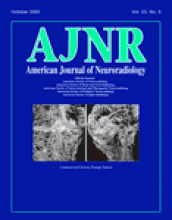Abstract
BACKGROUND AND PURPOSE: MR sialography has become an alternative imaging technique for ductal salivary gland diseases. We compared the diagnostic accuracies of MR sialography and digital subtraction sialography in patients with successful completion of both examinations and benign salivary gland disorders.
METHODS: In a prospective study, we attempted to examine salivary glands in 80 patients with clinically suspected diagnoses of sialadenitis and/or sialolithiasis. Each patient underwent digital subtraction sialography and MR sialography. MR sialography was obtained with a T2-weighted single-shot turbo spin-echo sequence (TR/TE 2800/1100 msec, acquisition time 7 seconds), with use of a quadrature head coil. Final diagnoses were confirmed by clinical follow-up and results of biopsy (n = 9) or surgery (n = 19).
RESULTS: Failure rate was 5% (four of 80) for MR sialography and 14% (11 of 80) for digital subtraction sialography. Eighty-one salivary glands (48 parotid, 33 submandibular) in 65 patients were successfully visualized with both modalities. MR sialography depicted the main ductal system and first- and second-order branches, whereas digital subtraction sialography was able to depict third-order branches. Sensitivity and specificity to diagnose chronic sialadenitis were 70% and 98% with MR and 96% and 100% with digital subtraction sialography. MR sialography enabled diagnosis of sialolithiasis with a sensitivity of 80% and a specificity of 98% versus 90% and 98% for each with digital subtraction sialography.
CONCLUSION: MR sialography with a heavily T2-weighted sequence is highly successful in the noninvasive visualization of the ductal system of major salivary glands. It is useful for diagnosing sialolithiasis and sialadenitis. Digital subtraction sialography, an invasive technique, had a substantial procedural failure rate, particularly for the submandibular duct. However, because of its higher spatial resolution, successfully completed digital subtraction sialography achieved superior diagnostic information compared with that of MR sialography.
- Copyright © American Society of Neuroradiology







